Sichuan 四川 meaning four rivers is also known as the ‘Heaven’s Granary’ 天府之国’. It has an area of 485,000 square kilometers and a population of over 80 million. It provides the natural habit for pandas and is known for its rich history, culture, cuisine, stunning landscape and scenery. I took the Sichuan-Tibet Highway and visited Daocheng 稻城 and Yading 亞丁 on my way to Chengdu. I went to Mt. Emei 峨嵋山, Mt. Siguniang 四姑娘山 and Mt. Qingcheng 青城山 (all World Heritage Sites) before taking an 18-hour train to Kunming, Yunnan 云南昆明.
Sichuan borders Tibet, Qinghai, Gansu, Shaanxi, Hubei, Chongqing, Hunan, Guizhou and Yunnan. The Qinghai-Tibet Plateau 青藏高原slopes from the western side down to the fertile Sichuan plain. There are glaciers, alpine forests, rich wildlife and lush vegetation. There are over 1300 rivers. Mt. Gonggashan 贡嘎山, the highest peak in Sichuan stands at 7556m and the second highest is Mt. Siguniang (The Four-Sisters-Mountains) 四姑娘山 at 6250m.
Sichuan has a long history and culture. The archaeological discovery of the late-Shang dynasty 商代 culture of Shu蜀 at Sanxingdui 三星堆 with some of the objects up to 4900 years old and the sophisticated irrigation system developed by a famed engineer, Li Bing李冰 at Dujiangyan 都江堰in the 3rd century BC are just two examples illustrating the high level of development of this region.
Sichuan is one of the most fascinating provinces for travellers. China has 41 World Heritage Sites out of which four are in Sichuan namely the Mt. Emei scenic area including the Giant Buddha scenic spot, Huanglong 黄龙 scenic and historical interest area, Jiuzhaigou Valley 九寨沟scenic and historical interest area, Great Panda Sanctuaries at Wolong 卧龙熊猫基地, Mt. Sigunian and Jiajin Mountains 夾金山, and Mt. Qingcheng and Duijianyan Irrigation System. During my two previous visits to Sichuan, I visited most of these sites except Mt. Emei, Mt. Qingcheng and the Great Pandas Sanctuaries.
September 11-18: Sichuan – Tibet Highway with a side trip to Daocheng 稻城 and Yading 亚丁
Days 1- 4 (September 11- 14 pm): Tibet from Lhasa to Markhem – Pl read China (6).
Day 4 (September 14, Wednesday): Zuogong 左贡 – Markham 芒康 – Jinshajiang 金沙江 – Batang 巴塘, Sichuan (170km)
In order to avoid traffic jams, we set off at 5:30pm and got over the Dongda Pass 东达山口(5008m) before 7am. We saw the Lancangjiang 澜沧江 (also known as the Mekong River) and had lunch at Markham, the last Tibetan town before crossing the Jinshajiang into the Sichuan Province.
We reached Batang, 32km from the border at 3:30pm. The town looks relatively new and the Kanglin Monastery 康宁寺is probably the oldest building in town. After an early dinner, I went to the town square to watch locals dancing. The weather was warm and many were hanging out to drink tea or beer. The atmosphere is laid-back and cheerful. I was tired but could not sleep as the restaurant opposite our hotel had a party and the young people were dancing and singing till midnight. People in the Mainland are not bothered by noises, but I find loud noises unbearable. I wish people could be more considerate.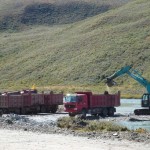
Day 5: Batang 巴塘 – Litang 理塘- Daocheng 稻城 (330km)
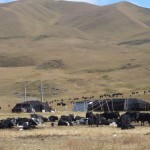 We had a bumpy ride from Batang to Litang (about 190km). But the scenery is impressive with grassland, lakes, alpine trees, thousands of sheep grazing on a hillside. Then we passed a long stretch of grassland (which is said to have an area of some 5000 square kilometers). We saw numerous tents of the nomads who move with their herds.
We had a bumpy ride from Batang to Litang (about 190km). But the scenery is impressive with grassland, lakes, alpine trees, thousands of sheep grazing on a hillside. Then we passed a long stretch of grassland (which is said to have an area of some 5000 square kilometers). We saw numerous tents of the nomads who move with their herds.
We arrived in Litang a thriving prosperous trading town for lunch. Litang is famed as the birthplace of the 7th and 10th Dalai Lama. Chinese caterpillar fungus 藏东蟲草 and an expensive mushroom 松茸 (matsutake in Japanese) are found in the region. While my Mainland friends had noodles for lunch, the driver Xiao Xu and I had a sumptuous hot-pot with yak meat and intestine. Xiao Xu insisted on paying: the meal only cost ¥80.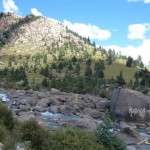
We arrived in Daocheng after 6pm and stayed in a nice hotel. In order to save money, my roommates decided to take two standard rooms (one room for the two men and one for three of us). I had a bed while they cramped into the other bed. As a result, both of them slept badly and one even had high altitude sickness the following day. (I felt uneasy and paid for a single room for myself the following night)
Day 6: Daocheng 稻城 – Yading 亚丁 – Daocheng 稻城 (220km)
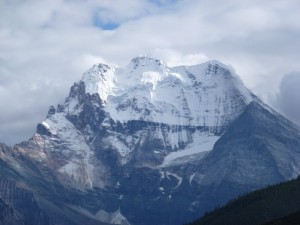 Visitors come here to see the Yading Scenic Area 亚丁自然保护区 which has a total area of 560,000 hectares. The reserve is built around three holy peaks namely Jampelyang 文殊菩萨(5958m), Chagna Dorje 金刚手菩萨 (5958m) and Chenresig 观世音菩萨 (6032m) with stunning scenery with alpine trees, pasture, lakes and numerous snowed – capped mountains.
Visitors come here to see the Yading Scenic Area 亚丁自然保护区 which has a total area of 560,000 hectares. The reserve is built around three holy peaks namely Jampelyang 文殊菩萨(5958m), Chagna Dorje 金刚手菩萨 (5958m) and Chenresig 观世音菩萨 (6032m) with stunning scenery with alpine trees, pasture, lakes and numerous snowed – capped mountains.
We set off after 7am and arrived at Yading (3900m) around 9:30am. The park fee is ¥120, As I wanted to reach the Niunai Hai (Milk Lake) 牛奶海 at 4720m, Xiao Xu said I should take a horse-ride (¥40 one way) to the electric car depot and then a 7-km ride to the Luorong Pasture 洛绒牧场 (¥80 return). From there, I could take a horse-ride for ¥300 return and I must be back at 4pm.
I followed Xu’s advice. The horse ride took less than 15minutes (I gather the distance is no more than 2 km) and the 7-km ride on the electric car along the valley is pleasant. The scenery along the valley and at the Luorong Pasture is similar to those at Jiuzhaigou but as not pretty.
I intended to take a horse ride to the lake which is about 5-6 km away. All the horses had been taken and I had to wait till 2pm for my turn. As I had to meet up with the group to leave at 4pm, I decided to go as far as I could so that I could have a better view of the three sacred peaks. I would turn back around 1pm.
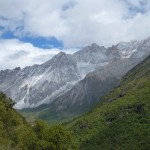 |
|
I set off around 11am. As there was no proper signage, I had to return to seek information thus losing some 20 minutes. The track is not too difficult till one has to climb a steep zigzag slope to a pass. By 1pm, I reached the top of the pass and sighted the lake. It is foolish to give up: I pushed on and finally reached the lake around 1:30pm. I took a few pictures and started my descent. Still I was half an hour late. (My friends did not take any ride: they went on foot to the Chonggu Temple 冲古寺and the Pearl Lake 珍珠湖.)
Day 7: Daocheng 稻城– Litang 理塘 – Kangding 康定 (430km)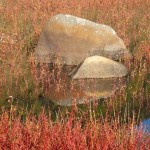
I found the scenery relatively dull after having seen areas of exceptional beauty for the past six weeks. We set off at 8am, took the same route back to Litang and were back on Highway 318 again. Our car was stuck in traffic several times as earth -moving vehicles were leveling the road or removing soil and rocks off the road. It started to rain after lunch and it was grey and cold. The condition of Highway 318 on this section is very bad until we got back on paved road near Xinduoqiao 新都桥, a popular overnight stop for tourists. I do not find it as charming and photogenic as people have described.
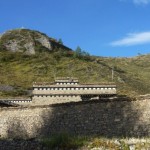 |
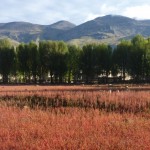 |
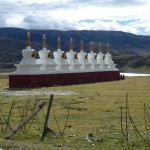 |
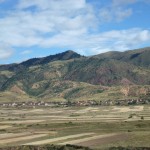 |
The hotel we intended to stay was full. It was 7:30pm and was getting dark. As the road is in good condition, Xiao Xu decided to drive another 70km to Kangding 康定. It became very foggy with poor visibility. It was scary to drive on a long and winding road with dozens of sharp bends in a foggy evening. Xiao Xu drove slowly and we were relieved when we reached Kanding at 9pm. A tiring and dull day!
Day 8 (September 18, Sunday): Kangding 康定- Chengdu 成都 (350km)
Kanding located in a narrow river valley has been named as a ‘love song city’ because of a folk song ‘Kanding Love Song’ 康定情歌. The popular song has painted a romantic picture with a young man riding on his horse galloping on grassland to meet the girl he loves. I got up at 6am and took a walk hoping to find a romantic Kanding. Too many developments have taken place and the old Kanding has sadly gone.
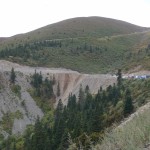 |
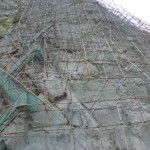 |
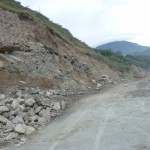 |
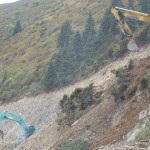 |
We set off at 7:30am and made excellent progress. We stopped at a 100-year old family restaurant specialized in steam chicken and chicken dumplings. We had a most delicious brunch for only ¥125. We arrived in Chengdu shortly after 3pm and the driver dropped me off Sam’s Guesthouse near the Tianfu Square. I was pleased to have a single room for ¥120 in the 300-year old Shanxi Clubhouse 成都陕西会馆 where there is a traditional garden with matured plants and a pond with golden fish. It is quiet and atmospheric!
I called Hua Jie 华姐, owner of the Kyi Shol Hotel in Lhasa. She lives near the New Century underground station. I took the underground and found the design of the stations and trains has a ‘Hong Kong’ feel! Hua Jie is a great cook and I had the best chicken soup and braised chicken. What a treat!
September 20-22: 3-day trekking in Mt Emei峨眉山
There are four famous Buddhist mountains in China namely Mt. Emei in Sichuan, Jiuhuashan in Anhui 安徽九华山, Putuoshan in Zhenjiang 浙江普陀山 and Wutai in Shanxi 山西五台山.
Bodhisattva Puxian 普贤菩萨 is the protector of Mt. Emei. Most tourists take one to two days to visit the key attractions including the BaoguoTemple (Nation-dedicating Temple) 报国寺, Long Life Monastery 万年寺 and Golden Summit Temple 金顶寺which are accessible by bus and cable car. Trekkers may take three to four days to walk 60-80km in order to see a dozen of temples which scatter along different paths.
Day 1: Chengdu 成都 – Baoguo town 报国寺镇 – Long Life Monastery 万年寺 – Jiuling Gang 九岭崗(14km; about 4 hrs)
Mt. Emei is easily accessible by bus or train from Chengdu. I took a bus at 10 am and arrived at town near the BaoguoTemple 报国寺at 12:30pm. After lunch I took a shuttle bus to the Long Life Monastery 万年寺 car park and started my trek at 2pm. It took 40 minutes to reach the monastery dedicated to Bodhisattva Puxian 普贤菩萨. Reconstructed in the 9th century, it is the oldest surviving temple. One of the treasures is an 8.5m high statute cast in copper and bronze of Bodhisattva Puxian dated from AD 980. It is housed in a unique yellow Brick Hall with a square base and a round roof.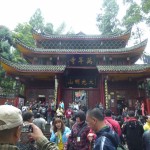
I intended to stay overnight at the Elephant Bathing Pool 洗象池which is 15 km away. As it had rained in the morning, there were fewer visitors than usual. I left the Long Life Monastery at 3:30pm and only met a dozen people coming down. It was misty and started to get dark. I was scared and hoped to find a companion. Half way up, I met a porter on his way down. As he had no business the whole day, he was desperate to earn some money. He proposed to carry my backpack to Jiuling Gang for ¥70.
I felt better with a companion and arrived at Jiuling Gang at 6:30pm. There are two guesthouses and I was the only lodger. The place is damp and cold. I managed to keep myself warm in my own sleeping bag.
Day 2: Jiuling Gang 九岭崗- Golden Summit Temple 金顶寺 – Immortal Peak Monastery 仙峰寺 (25 km; 9 hrs)
I left my backpack at the guesthouse and set off at 7am. It was a miserable, rainy and misty day with very poor visibility. The Elephant Bathing Pool Temple 洗象池寺 which is under restoration has a small pool outside where it is said that Puxian flew with his elephant in for a scrub. It is a strenuous walk with steep and endless steps to the Elephant Bathing Pool and the Jieyin Temple 接引寺.
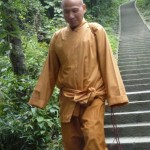 |
|
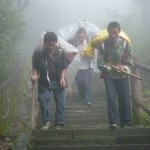 |
I reached the cable car station around 11am. As it was raining and it is said that the hike to the famous Golden Summit Temple might take over two hours, I decided to take a ride. As there were hundreds of tourists arriving in tourist buses, I queued for over an hour for a 5-minute ride to the top. The Temple standing at 3077m with glazed tiles and the golden statute of 4-faced Bodhisattva Puxian are new and impressive. They look golden and shine brilliantly in sunlight. Unfortunately they were hardly visible in the thick mist.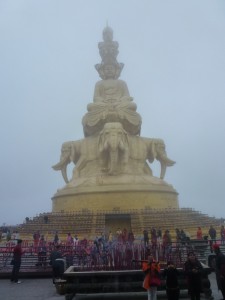
I left the summit at 1pm and took two and a half hours to reach the Elephant Bathing Pool at 3:30pm. I arrived at the guesthouse at Jiuling Gang at 4:30pm. The guesthouse owner advised me to stay at the Immortal Peak Monastery which is 12.5km away as Hongchunping (Venerable Trees Terrace) 洪椿坪 with better accommodation is another 15km away. As it was getting late with hardly anyone on the road, I decided to hire a porter to carry my backpack. It is an easy descent. I reached my destination just before 6pm and paid ¥120 for the service.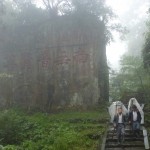
The Immortal Peak Monastery is run-down and under restoration. It was the first time in my life to stay in a Chinese monastery. The rooms located on the first floor are dark with toilets at the end of a long corridor. I paid ¥50 for a bed in a 4-bedded room. In the end, I had the whole room.
Day 3: Immortal Peak Monastery 仙峰寺 – Wuling Gang 五岭岗 (22.5km; 4 hrs 30 minutes) – Baoguo Town 报国寺镇 – Chengdu 成都
I got up before 6am and set off at 7am when it was still dark. I did not want to walk alone and hired a lady porter to carry my backpack. She would only accompany me to Hongchunping which is 15km away. She asked for ¥130 as she had to spend three hours on the return journey. We reached Hongchunping at 8:30am without seeing a soul!
|
|
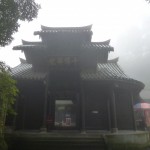 |
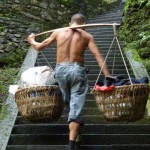 |
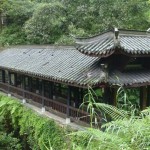 |
The monastery at Hongchunping is tranquil, charming and elegant resembling a home of a noble or scholar. The guestrooms are tidy and comfortable. The public toilets which are built in the traditional squat style are airy, clean and without smell. I wish I had stayed there instead of the Immortal Peak Monastery.
As the mist had cleared up a bit, I had a chance to see the landscape and scenery on the way to the Pure Sound Pavilion 清音阁. But I also had scaring encounters with monkeys. Two monkeys jumped on my backpack and almost gave me a heart attack. Another snatched a plastic bag from one of the side pockets of my handbag. Several angry looking monkeys blocked my way. I feared they would jump onto me or scratch my face or head. When I saw a park cleaner, I yelled for help. She ignored my plea and walked on. Finally a group of students and visitors arrived. As the monkeys had new targets, they left me alone!
The Pure Sound Pavilion is 3.5km from the Wuling Gang 五岭崗 entrance where there are lots of hotels. The scenic area with the pavilion built on an outcrop in the middle of a fast- flowing stream, a planked footway built along a narrow gorge, lush vegetation, clear streams, many lovely pools and plenty of monkeys attract thousands of tourists a day during the peak season. After being alone most of the time during my 3-day trek, I found the noisy tourists unbearable. I reached the visitor centre at Wuling Gang at 11:30am where I took a shuttle bus back to the Baoguo Temple. (I could have taken another trail and walked another 15 km to return to the Baoguo Temple. But I did not want to get too exhausted.)
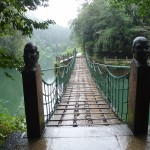 |
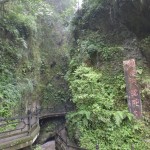 |
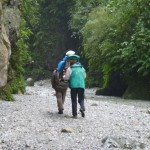 |
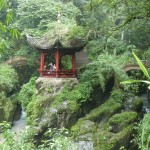 |
I visited the Baoguo Temple which looks new after extensive restoration. After lunch, I took the 2pm bus back to Chengdu. My legs were started to get sore. I stayed in the guesthouse the next day to recuperate.
September 24-27: 4-day trekking in Mt. Siguniang 四姑娘山 and Mt. Qingcheng 青城山
Day 1: Chengdu 成都 – Shuangqiaogou, Mt. Siguniang 四姑娘山双桥沟 – Rilong 日隆(360km)
Mt. Sigunian has been described as “the Queen of Sichuan Mountains”. The scenic area comprises three valleys namely Shuangqiaogou 双桥沟, Changpinggou 长坪沟 and Haizigou 海子沟. It is 200km from Chengdu via Dujiangyan. Unfortunately the catastrophic earthquake taking place on May 12, 2008 has destroyed the highway at Wolong 卧龙 and buses have to take an alternate route which is 360km long via the Cheng-Ya Highway.
It is a long journey. I left Chengdu at 6:30am and found the scenery dull for the next four hours till the bus turned off the Cheng-Ya Highway. Then I had a wonderful ride on a zigzag road going through the Jiajin Mountains area with alpine trees, picturesque villages and golden fields. A retired couple and I were dropped off at 1:30pm when we were some 15 km from Rilong. A minivan took us to the Shuangqiaogou.
The valley is 30-km long and visitors have to take a shuttle bus (¥70 return). Instead of having a ticket covering the three valleys, visitors have to buy separate tickets. It was a beautiful and sunny day with blue sky and white clouds. The valley with snow-topped mountains in all directions is photogenic. Some 70 Tibetan families are still living in there. The shuttle bus stopped at six scenic spots for photo-taking. The scenery is said to be breathtaking with the autumn foliage.
I spent three hours in the valley. But it was not enough: I had no time to walk on the plank foot path. The driver then took us to the lookout point at Maobiliang (Bridge of a cat’s noise) 猫鼻樑。 We were lucky to catch a glimpse of Mt. Siguniang just before the clouds set in.
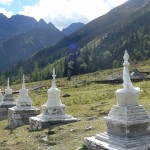 |
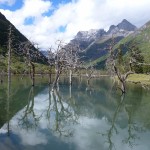 |
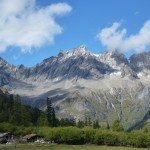 |
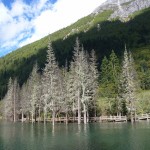 |
The driver charged us ¥30 each for his service and took us to his friend’s newly opened guesthouse in Rilong. I paid ¥50 for a room. I found the place gloomy and moved the next day to a more comfortable guesthouse.
Day 2: Changpinggou, Mt. Siguniang 四姑娘山长坪沟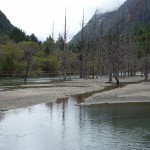
The weather changed quickly. It was still raining when I reached the park at 9am. In addition to the ¥70 entry fee, I had to pay ¥20 for a shuttle bus which took visitors to a lama monastery 7km away from the entrance.
The full length of the valley is 36km with a plank road covering the first six kilometers. The narrow valley flanked by mountains with alpine vegetation on both sides, affords superb views of the four peaks of Mt. Siguniang. The place was deserted with few tourists. I thoroughly enjoyed my walk though it was too misty to see much.
When I reached the end of the planked footway, I wanted to go on and reach the foothill of Mt. Siguniang. But the path was too muddy. I therefore paid ¥200 for a horse-ride. It remained cloudy and I could just see the foot of Mt. Siguniang. What a pity!
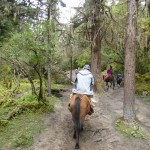 |
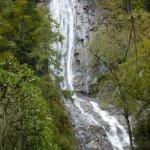 |
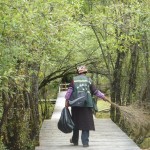 |
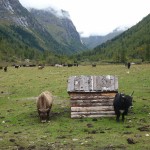 |
The saddle was most uncomfortable. I preferred to walk once I arrived at the planked footway. I finally arrived at the lama monastery at 4:30pm. I had a good day though the weather was disappointing. I like this mountain and shall return one day to see its glorious autumn colours and visit all the valleys.
Day 3: Rilong 日隆 – Dujiangyan 都江堰 – Mt. Qingcheng 青城山 (about 150km)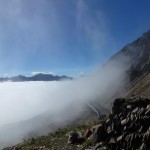
I found a private car going to Dujianyan from where there are buses going to Mt. Qingcheng. I sat off with two other passengers at 8:45am. It was a sunny day. I had fantastic views of the mountains. But once we got over a pass, it was cloudy and misty again. There was however a beautiful sea of cloud.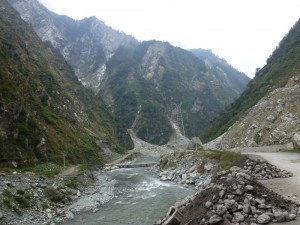
The paved road to Wolong has not been damaged by the devastating earthquake. But the next 27km in the direction of Dujiangyan is perilous. My heart sank as I saw the broken power lines, bridges and houses that have been destroyed during the earthquake. The panda sanctuary at Wolong 卧龙 was closed and the pandas have been moved to Ya’an 雅安 Serious landsides have also brought millions of boulders of all sizes to the river valley. Stones keep falling from the hillside. I was told it would take a few more years to re-build the road.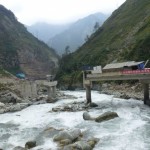
I arrived in Dujiangyan before 1 pm and took Bus 101 which cost ¥2 to Mt. Qingcheng. After leaving my backpack in a family-run guesthouse, I began my ascent to the top of Mt. Qingcheng. The entry fee is ¥90 and there is a circuit road which takes 4-6 hours depending on one’s speed and time spent in sight-seeing en route.
Mt. Qingcheng is a Taoist holy mountain. The mountain is famous for its lush vegetation with plenty of bamboos, cypress and pine trees. There are many temples providing useful rest stops. Though the trails are generally well-paved and maintained, I found some sections very narrow, slippery and dangerous. I was scared and walked with extra caution. At the top (1260m) is a new 8-storeyed Laojun Palace 老君阁 built after the earthquake. I note that the Taoist organizations in Hong Kong have donated for its construction. I had a quick tour before it was closed shortly after 4:30pm.
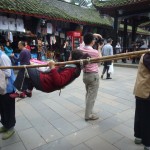 |
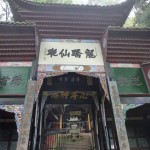 |
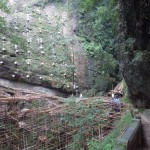 |
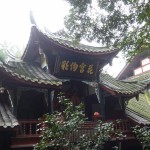 |
I did not take the cable car and completed the circuit on foot. The trail is wider and not as steep but there is not much to see. I reached the foothill at 6pm, had a nice dinner (as I had skipped lunch) and went to bed.
Day 4: Qingcheng Houshan 青城后山 – Chendgu 成都
There are two scenic areas namely Mt. Qingcheng (also known as the front mountain) and Qingcheng Houshan (the back mountain) which is 15km away and has over 20km of trails in a more natural setting. This area has been more affected by the 5.12 earthquake with tons of boulders falling from the top. The largest boulder is said to weigh some 1000 tons. As a result, some of staircases/footpaths have collapsed making it dangerous for visitors. While there are not as many temples, Qingcheng Houshan is more charming and beautiful for trekkers. The planked path built from cliffs and dozens of caves with sculpture also makes it more interesting.
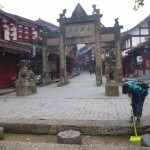 |
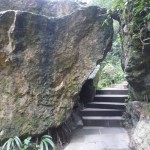 |
|
|
I stopped at Tai’an 泰安,a lovely ancient town which has been affected by the earthquake. I started my hike around 9:30am walking up the Five Dragon Valley 五龙沟 which is most scenic with a 600-m long planked foot path through a very narrow gorge. I then met four nice young people from Chendgu who became my companions for the rest of the hike. I fell twice and they got very concerned. They found me a stick and I had no more mishaps.
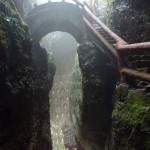 |
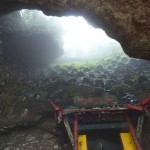 |
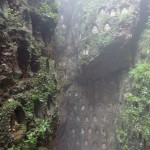 |
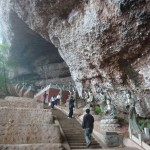 |
The Baiyun Temple complex 白云寺 sits at the top of the mountain at 1700m. To reach the temple, one has to go through a cave which has hundreds of Buddha statutes on the walls. It is an amazing and unforgettable sight! Unfortunately, the earthquake has caused so much damage that the temple has been closed for repair.
After a 7-hour hike, we were tired and hungry. I invited them for a late lunch at Tai’an. I picked up my backpack from the guesthouse and took the 6:40pm-high-speed train to Chengdu. The 45-mintue ride only cost ¥15. This is the most enjoyable day I had during my 16-day stay in Sichuan.
September 28: Chengdu 成都 – rest day
I called Hua Jie to say good-bye and we met up an hour later. She took me to have tea with her friends in an old district along a canal. Hundreds of people were sitting on both sides of the canal drinking tea and chatting. Some were playing mahjong. Customers pay ¥3 for a pot of tea and may stay for hours. This is the leisure life style in Chengdu. I then joined her friends and had a delicious hot-pot dinner. Afterwards, I went to two popular night spots namely Kuanzhai Alley 宽窄巷子 and Jinli Street 锦里古街 both have well-preserved buildings which are now turned into restaurants, bars, shops and galleries etc.
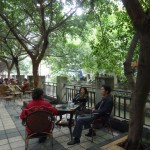 |
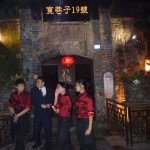 |
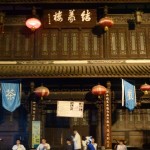 |
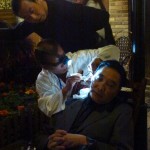 |
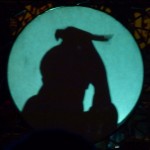 |
September 29: Chengdu 成都 – Kunming 昆明 by train (1083km)
I visited the Wenshu Monastery 文殊院 which is an important temple for Zen Buddhism. Before leaving for the train station, I went to the Hong Kong government office to see former colleagues. It is always nice to catch up with old friends and have the latest news on Hong Kong.
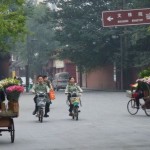 |
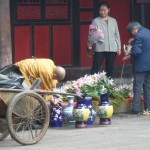 |
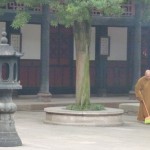 |
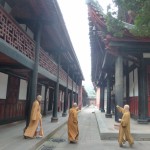 |
My tain departed on time at 1:08pm. I had a good sleep as I had a berth in a 4-berth compartment for ¥390. I arrived in Kunming in good shape before 8am the following day.
Remarks
This is my third visit to Sichuan. This trip has opened my eyes to the real Sichuan including its life style and nice people and magnificent landscape and scenery.
My 2600-km journey from Lhasa to Chengdu is unforgettable. The landscape and scenery are fascinating and most impressive. From the Qinghai-Tibet Plateau at 4000-5000m, I have descended to the Sichuan plain after going over numerous pass over 5000m, passing through countless beautiful gorges, seeing expansive grasslands and crossing the Nujiang, Lancangjiang and Jinshajiang.
I did not know much about Sichuan before this visit. Apart from its cultural attractions including temples and museums etc, I have now discovered its natural beauty. I enjoy my hike in Mt. Sigunian and Mt. Qingcheng. Yunnan and Sichuan with their spectacular landscape, scenery and diversity are both excellent places for trekking. I shall come back to trek in Sichuan next year if possible.
I am impressed by the Sichuan people. They are open, warm and hard-working. Sunny and Terry from the Sam’s Guesthouse have made me feel at home. Hua Jie has introduced me to her friends and made me welcomed. I get along so well with Xiao Xu (the driver) that we have already planned another driving trip to explore other parts of Sichuan before going to Tibet, Qinghai, Xinjiang and Gansu.
Wolong will take years to recover from the damage caused by the catastrophic 5.12 earthquake. It requires tremendous efforts and resources to rebuild the area. I hope things go well and I can find a thriving community including pandas on my next visit to Wolong
China has ambitious plans to develop the western part of China with Sichuan playing a key role. The province seems to have reasonably good infrastructure with high-speed trains to Chongqing. Conditions of Highway 318 from Ya’an to Batang (part of the Sichuan-Tibet Highway) are very bad. On completion of the improvement work, I believe it will provide further impetus for economic development of both Sichuan and the whole region.


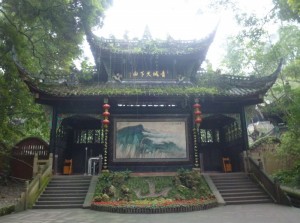
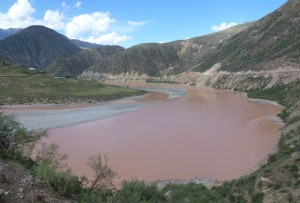
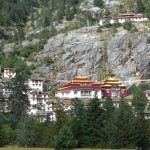
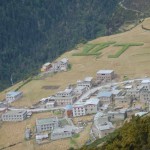
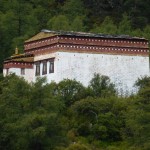
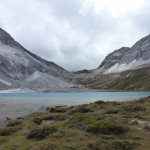
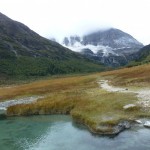
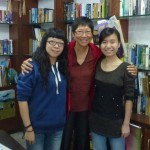
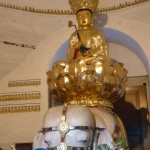
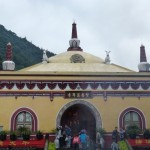
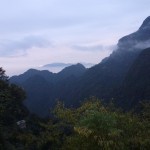
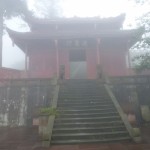
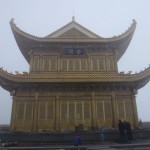
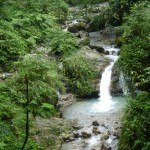
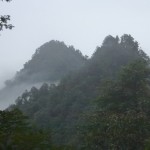
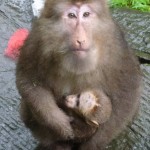
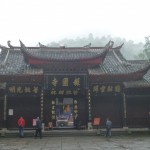
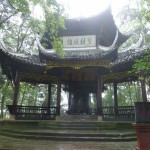
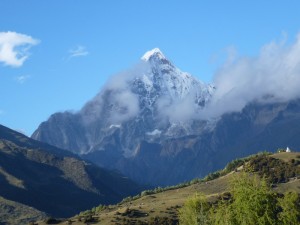
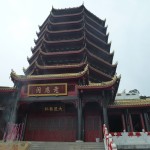
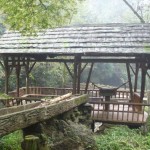
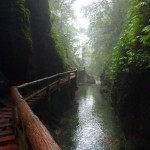
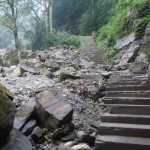
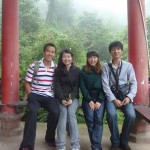
hello!sarah Wu.can you remember me?i’m one of the four young peple.how is everthing going?I admire you, also hope that one day i can travel like you.I often look to your website .I would also like to send you pictures on Qingcheng Houshan . my MSN is sy9250@hotmail.com.
Hi Sarah:
Those pictures you took are amazing! Those names of places that you visited reminded me of the romantic swordsmanship stories of Jinyong. Now I understand more of what he described in his writings. Glad to see what you have visited. Take care!
Paulina
Hi Sarah,
Remember me? I just spoke with Gardi, and she said you had this website with all your travelogues. Wow! You really do get around. My husband and I were in Tibet too, but only for 9 days (Sept 14-23). Keep in touch, and happy travelling!